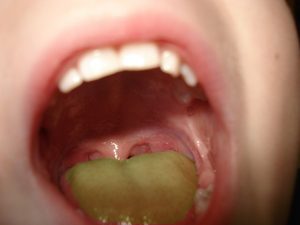If you google various illnesses, there will be a lot of articles dedicated to helping you diagnose and treat most common ones.
You may even be able to ask your friends because everyone has had things like fatigue or sore throats before.
Sometimes, however, your symptom may be something simple yet no one you know has experienced it. It might even be really embarrassing to talk about.
You know what to do when you have a sore throat, or when you have a backache, but what do you do if your tongue turns green?
It may seem like a simple thing, but noticing a change in the color of your tongue from the normal pink or red to something so strange may be a really disconcerting experience for you, and it isn’t something you should ignore.
In reality, the tongue itself isn’t green. Instead, the green color comes from a film like coating on the surface, which is good news when you’re probably wanting to get rid of it!
The tongue isn’t something we spend a lot of time thinking about, but its condition and overall health can point to imbalance or disease in the body. Both Western medicine and more traditional medical practices use the tongue as a litmus test for the condition of certain aspects of your health.
Your body is telling you something and it isn’t that you’re turning into the Hulk.
You may not know where to start finding out why your tongue is green, and you may be hesitant to make a trip to the doctor just for this symptom.
However, there are actually quite a few reasons why this can happen, and they have nothing to do with science fiction.
It’s important to take note of any other symptoms, as well as recent behaviors that might be contributing to this condition, but before we get there, let’s talk a little more about the tongue’s role in diagnosing illness or imbalance in the body.
You may be surprised at all the things your tongue can tell you!
Western Medicine
 In Western medicine, doctors may look at the tongue for a few different reasons. For example, a swollen tongue may be a sign of hypothyroidism or an inflamed tongue could prompt them to check your vitamin B levels.
In Western medicine, doctors may look at the tongue for a few different reasons. For example, a swollen tongue may be a sign of hypothyroidism or an inflamed tongue could prompt them to check your vitamin B levels.
Western medicine focuses a lot on the physical systems of our body, things like vitamins or the digestive system, and so the appearance of the tongue is sometimes a good indicator of deficiencies in these systems.
There are quite a few ways that Western medicine explains a green tongue. In most cases, a green tongue indicates a simple oral hygiene issue.
If you aren’t taking good care of your mouth, debris and bacteria can build up on the surface of the tongue and create an inhospitable environment. This environment contributes to the green film-like coating on the back or over the entire surface.
Another possible cause is the extended use of antibiotics.
According to the report by the Universitat de València, antibiotics cause gut flora to change and may cause changes in your overall gut health.(1)
When this happens, it’s possible that this change will affect the surface of your tongue as it is the first step to your gut.
Oral thrush, a condition caused by a fungal infection in the mouth, is a common opportunistic organism that will take over if your natural flora changes.
The source is usually Candida albicans, a fungus that often finds the chance to thrive in environments where the natural bacteria is compromised, or where there is little hygiene. Again, this is caused by a number of things including antibiotic use.
Western medicine is a little more skeptical of the tongue’s ability to indicate serious illnesses or imbalances in the body, though more and more research seems to indicate that it might be a more credible link than previously thought.
In fact, some research is now showing that the use of the tongue to diagnose imbalance in two traditional health practices, TCM and Ayurveda, may not be off base.
Traditional Chinese Medicine
Since the tongue is one of the key examination sites for Traditional Chinese Medicine (TCM), the presence of a green tongue is significant.
TCM practitioners look at the shape, surface, color, and coating of the tongue for all patients regardless of any known illnesses, and so a green tongue can indicate quite a few imbalances in the body, ranging from minor to significant.(2)
Unlike Western Medicine, TCM practitioners rely on the tongue for a spectrum of information. For example, teeth marks on the side of the tongue relate to sluggishness, fatigue, or some kind of liver inflammation.(2)
Although the tongue may seem to have nothing to do with any of those things, TCM views the tongue as a direct link to many of the energetic systems of the body.
The traditional interpretation of a green tongue is stagnant energy or the presence of excess evil within the body. The “Yang” or the dynamic energy is not properly moving blood through the body and is the source of this energetic stagnation.(2)
Dark marks on the side of the tongue, including green spots, correlate directly to stagnation in the liver portion of the body, and could indicate high levels of stress or even more serious diagnoses like cirrhosis or cancer.
Whether you subscribe to the traditional interpretation or not, studies are beginning to show that the condition of the tongue is directly related to health in the body.
For example, researcher Yang Cai, a member of the Carnegie Mellon Biovision Lab, studies the link between the tongue and certain forms of cancer.(3)
He is the creator of a program designed to analyze the tongue in ways that TCM practitioners would do, and his program is showing these links. The computer uses a color spectrum to examine the tongue in ways that TCM practitioners do but removes the subjectivity of the exam.
Cai is working on the database that would allow the program to identify these imbalances.
At this time, the study is only available in Chinese, but according to Cai, it is possible that there is a link between the tongue’s appearance and difficult to detect cancers.
Ayurveda
 Ayurvedic Medicine, like TCM, also uses the tongue as a diagnostic tool for a wide range of imbalances in the body, particularly energetic imbalances.(4)
Ayurvedic Medicine, like TCM, also uses the tongue as a diagnostic tool for a wide range of imbalances in the body, particularly energetic imbalances.(4)
There are three different “doshas” or combinations of mind and body energetic connections, Vata, Pitta, and Kapha. Each dosha controls functions of the body, and each one will have a unique set of symptoms and ways to correct an imbalance.
Because these systems are so interconnected, the tongue might signal improper nutrient absorption and accumulation of toxins. It can also be a sign of emotional stress, especially those emotions held in the spine, organs, or shoulders.
A coating on the tongue signals a buildup of toxins in the body and poor digestion. Green specifically is a buildup of Pitta toxins. This means the small or large intestine or the liver is inflamed or out of balance if the color is located near the back of the tongue.
If it’s located over the entire tongue, this is indicative of a blood imbalance or the presence of toxins in the bloodstream.
Now that we’ve examined the role of the tongue in three major medical practices, it’s time to look at what’s going on in your mouth. Take a minute to note any other symptoms you might be experiencing and read on.
Symptoms
Ok, your tongue is green. Done.
Not quite.
» What color green?
» Do you have a headache?
» Does your throat hurt?
» Have you been tired lately?
It’s not just the green tongue that’s giving you the signal that something is up with your body. There are probably other symptoms that you may not associate with the color of your tongue.
It’s important to take a look at your body and see if you have anything else that might help diagnose what’s going on.
For example, did you eat anything green in the last 24 hours?
If you did, then congratulations. That green lollipop is most likely the culprit.
If you haven’t, then you should examine how you feel, what you have eaten or taken recently that’s out of the ordinary and start narrowing down what’s happening.
Let’s take a look at green tongue with some other common symptoms.
Green Tongue and Dry Throat
 This combination is most likely caused by the aforementioned overgrowth of candida, or yeast, in the back of the throat.
This combination is most likely caused by the aforementioned overgrowth of candida, or yeast, in the back of the throat.
This condition is also called “Oral Thrush” and is common in babies, people with compromised immune systems, and anyone experiencing hormone fluctuations. (5)
Symptoms include the feeling that something is “stuck” on the surface of the tongue or in the back of the throat, bad breath, and green tongue coating.
The coating may also be yellow or black/brown.
Green Tongue and Headache or Blocked Sinuses
These symptoms are common to allergies. The green tongue coating is a buildup saliva and draining mucus. Other symptoms may include a sore throat due to mucus drainage and fatigue, according to ehealthforum.(6)
Green Tongue and “Hairy” texture
Green tongue and the sensation of hair or something being stuck to the tongue or back of the throat is a condition known as “Hairy Tongue.”
This sensation is caused by abnormal buildup of tongue papillae, which traps food, bacteria, and other debris.
This coating and extra papillae contribute to the hair like texture of the surface of the tongue. It is most often caused by poor oral hygiene, or by a soft food diet which doesn’t aid in the scraping of excess skin cells on the tongue. It can also be caused by chronic dehydration or radiation treatments.
Green Tongue With a Recent Tongue Piercing
This symptom is pretty straight forward.
If you’ve pierced your tongue recently and are experiencing green tongue, it is most likely a sign of infection, especially if the tongue coating is accompanied by signs of redness or puss at the piercing site.(7)
Green tongue and Sore Throat
A sore throat with a green hue on the tongue may indicate an upper respiratory infection, according to healcure.(8)
One common cause of infection of this type is Strep throat. If Strep is the cause, you might also see white spots or pustules on the back of the throat and the tonsils.
Other causes are the common cold, rhinitis, and sinus infection.
Green Tongue and Nausea or Vomiting
Healthylifemed reports that several gastrointestinal disorders are associated with these symptoms.(9)
Since there is a direct link between your digestive system and your mouth, excess bile, and difficulty with digestion can affect the environment of the mouth.
The presence of bad breath may also indicate that your stomach isn’t producing the needed hydrochloric acid, and food is spending too long in your upper digestive system.
Treatment
Treatments will correspond to what is determined to be the cause of the discoloration. Either by altering the environment of the mouth, addressing a disease or imbalance, or removing the trigger, the tongue may return to its natural color.
Oral Hygiene
The most basic cause of discoloration is lack of proper hygiene in the mouth. It is important to brush and floss regularly and to brush or scrape the tongue to remove any trapped debris and buildup.
It is also necessary to remain properly hydrated as this both aids in balancing the body’s various systems associated with the tongue and further removes any debris and buildup.
Antibiotic Use
Examining how often you use antibiotics, and their different effects on the body will go a long way to helping your green tongue.
Antibiotics are often over prescribed, but if you have a need for one, be sure to stay mindful of your body’s internal environment. According to the Candida Diet, taking a probiotic along with an antibiotic may help your body maintain the natural gut flora that antibiotic use can sometimes disrupt.(10)
Respiratory Infections
Honey and Turmeric are natural sources of antibacterial and immune boosting compounds, and taking them may improve your tongue coloration by targeting harmful bacteria both in your mouth and your upper digestive tract.(7)
Honey can also help soothe an irritated throat, which is crucial for maintaining the overall health of your mouth. An irritated throat is a perfect breeding ground for harmful bacteria and other opportunistic pathogens.
Visiting the Doctor
If the symptoms persist, you should go ahead and visit your doctor or traditional practitioner. Visiting the dentist will get you some further recommendations for maintaining your oral health.
For your western doctor, blood work and other investigative tools will check to see if you have any major vitamin deficiencies or problems with your digestive system. It can also check the status of your respiratory health.
In TCM or Ayurveda, you may get a list of recommendations for more holistic approaches such as your overall diet and exercise based on your energetic constitution, rather than a traditional prescription.
In Ayurveda, your recommendations will align with Pitta energy since green tongue is a color associated with this type of imbalance. Certain combinations of foods and types of exercises will help to relieve the condition.
In TCM, you may be asked to add or abstain from certain foods and supplements to help realign your energy centers or to unblock stagnant energy contributing to the discoloration.
Conclusion
Whatever symptoms you have, it’s important to address them and not to ignore them, even if they are embarrassing or don’t seem like a big deal.
Changes in the body are its way of telling you that something is off and needs your attention.
If you have a green tongue keep this in mind:
» Examine and improve your oral hygiene habits
» Remove any outside triggers like antibiotics, if possible
» Visit your health practitioner, Western or traditional, for further advice
Further reading:
Orange Tongue – Why It Happens and How to Treat It?
References
(1)”sciencedaily.com/releases/2013/01/130109081145.htm
(2)”sacredlotus.com/go/diagnosis-chinese-medicine/get/tongue-diagnosis-chinese-medicine
(3)”cmu.edu/magazine/02fall/tongue.html
(4)Ayurvedic Tongue Diagnosis – Walter ‘shantree’ Kacera
(5)”nhs.uk/conditions/Oral-thrush—adults/Pages/Introduction.aspx
(6)”ehealthforum.com/health/topic30286.html
(7)”dentalstudio101.com/signs-may-tongue-piercing-infection/
(8)”healcure.org/tongue/coated-tongue/green-tongue-coating-causes-symptoms-diagnosis-in-baby-sore-throat-furry/
(9)”healthylifemed.com/why-is-my-tongue-green/
(10)”thecandidadiet.com/probiotics-while-on-antibiotics.htm
Leave Feedback: Was this article helpful?

